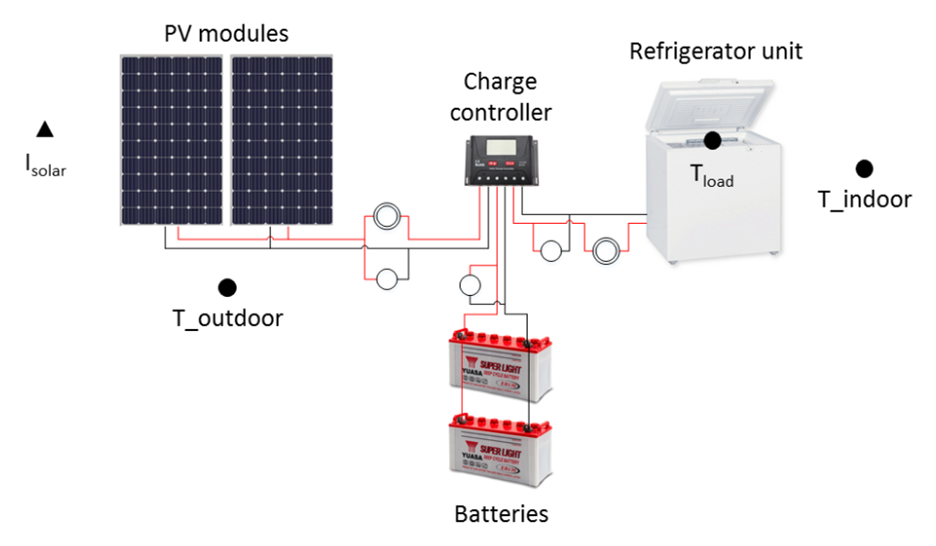Performance and ARX Modelling of a Solar Vapour Compression Refrigeration System
Keywords:
Solar Vapour Compression Refrigeration System, PV Module, Cooling, Food and Agroproducts, ARX ModellingAbstract
This study presents an experimental performance and an Auto-Regressive with Exogenous variable (ARX) modelling of a solar photovoltaic (PV) operated vapour compression refrigeration system. The system is composed of a conventional refrigerator and PV modules. The performance of the system was evaluated in terms of its cooling effect suitable for storage of food and agricultural products. The performance analysis clearly shows that a DC electric motor operated by solar PV with storage of electrical energy in batteries can be used for domestic applications using an environment-friendly renewable resource of solar energy. The ARX modelling of the system was performed. The agreement between the ARX simulated cooling temperature inside the cooling chamber and the measured cooling temperature inside the cooling chamber was good, with the discrepancy in terms of root mean square difference and mean bias difference being less than 10%. This finding suggests that ARX modelling provides a simple method for evaluating the system performance. The vapour compression solar refrigeration system can be used for cooling household products where electricity is unreliable or the electrical grid system is non-existent.
References
Hundy, G. F., Trott, A. R., & Welch, T. C. (2016). Refrigeration, air conditioning and heat pumps (5th edition). Oxford, United Kingdom: Butterworth-Heinemann.
Khurmi, R. S., & Gupta, J. K. (2008). A Textbook of refrigeration and air conditioning. New Delhi, India: S. Chand Publishing.
Vaidya, V. N., & Shelke, R. S. (2017). A review on solar power air compression refrigeration system for rural application. International Journal of Engineering Science and Computing, 7(3), 4922-4925.
Banjo, S. O., Ajayi, O. O., Bolaji, B. O., Emetere, M. E., Fayomi, O. S. I., Udoye, N. E., Olatunde, A. O., & Akinlabu, K. (2021). Evaluation analysis of a developed solar refrigerator using conventional refrigerant for rural and medical applications. IOP Conference Series: Earth and Environmental Science, 665, 012028.
Hammad, M., & Tarawneh, T. (2018). Performance study of a DC refrigerator powered by different solar PV modular sets: paper II. Journal of Dynamics of Machines, 1(1), 1-11.
Aktacir, M. A. (2011). Experimental study of a multi-purpose PV-refrigerator system. International Journal of Physical Sciences, 6(4), 746-757.
Ekren, O., Yilanci, A., Cetin, E., & Ozturk, H. K. (2011). Experimental performance evaluation of a PV-powered refrigeration system. Elektronika ir Elektrotechnika, 114(8), 7-10.
Sharma, N. K., Singh, H., Sharma, M. K., & Gupta, B. L. (2016). Performance analysis of vapour compression and vapour absorption refrigeration units working on photovoltaic power supply. International Journal of Renewable Energy Research (IJRER), 6(2), 455-464.
Mba, E. F., Chukwuneke, J. L., Achebe, C. H., & Okolie, P. C. (2012). Modeling and simulation of a photo-voltaic powered vapor compression refrigeration system. Journal of Information Engineering and Applications, 2(10), 1-15.
Su, P., Ji, J., Cai, J., Gao, Y., & Han, K. (2020). Dynamic simulation and experimental study of a variable speed photovoltaic DC refrigerator. Renewable Energy, 152, 155-164.
Gao, Y., Ji, J., Han, K., & Zhang, F. (2021). Comparative analysis on performance of PV direct-driven refrigeration system under two control methods. International Journal of Refrigeration, 127, 21-33.
Kutlu, C., Erdinc, M. T., Li, J., Wang, Y., & Su, Y. (2019). A study on heat storage sizing and flow control for a domestic scale solar-powered organic Rankine cycle-vapour compression refrigeration system. Renewable Energy, 143, 301-312.
Achuthan, M., Venkataraman, A., & Rathnasamy, R. (2011). Experimental analysis on the performance and characteristics of compact solar refrigeration system. Distributed Generation & Alternative Energy Journal, 26(3), 66-80.
Furler, G. (1993). Modelling of a photovoltaic powered refrigeration system (Master’s thesis). Madison, University of Wisconsin–Madison.
Ljung, L. (1987). System identification: Theory for the user. New Jersy, USA: P T R Prentice Hall.
Wasserman, P. D. (1989). Neural computation: Theory and practice. New York, USA: Van Nortrand Reinhold.
Doiebelin, E. (1976). Measurement systems. New York, USA: The McGraw-Hill Companies.
Holman, J. P. (2012). Experimental methods for engineers (8th edition). New York, USA: McGraw-Hill Companies.
Schenck, H., & Richardson, P. (1979). Theories of engineering experimentation. New York, USA: McGraw-Hill Companies.
Duffie, J. A. & Beckman, W. A. (2013). Solar engineering of thermal processes (4th edition). New York, USA: John Wiley and Sons.
Ríos-Moreno, G. J., Trejo-Perea, M., Castañeda-Miranda, R., Hernández-Guzmán, V. M., & Herrera-Ruiz, G. (2007). Modelling temperature in intelligent buildings by means of autoregressive models. Automation in Construction, 16(5), 713-722.
Blaifi, S. A., Moulahoum, S., Taghezouit, B., & Saim, A. (2019). An enhanced dynamic modeling of PV module using Levenberg-Marquardt algorithm. Renewable Energy, 135, 745-760.
O’Callaghan, J. R., Menzies, D. J., & Bailey, P. H. (1971). Digital simulation of agricultural drier performance. Journal of Agricultural Engineering Research, 16(3), 223-244.

Downloads
Published
How to Cite
Issue
Section
License
Copyright (c) 2022 School of Renewable Energy and Smart Grid Technology (SGtech)

This work is licensed under a Creative Commons Attribution-NonCommercial-NoDerivatives 4.0 International License.
All copyrights of the above manuscript, including rights to publish in any media, are transferred to the SGtech.
The authors retain the following rights;
1. All proprietary rights other than copyright.
2. Re-use of all or part of the above manuscript in their work.
3. Reproduction of the above manuscript for author’s personal use or for company/institution use provided that
(a) prior permission of SGtech is obtained,
(b) the source and SGtech copyright notice are indicated, and
(c) the copies are not offered for sale.








